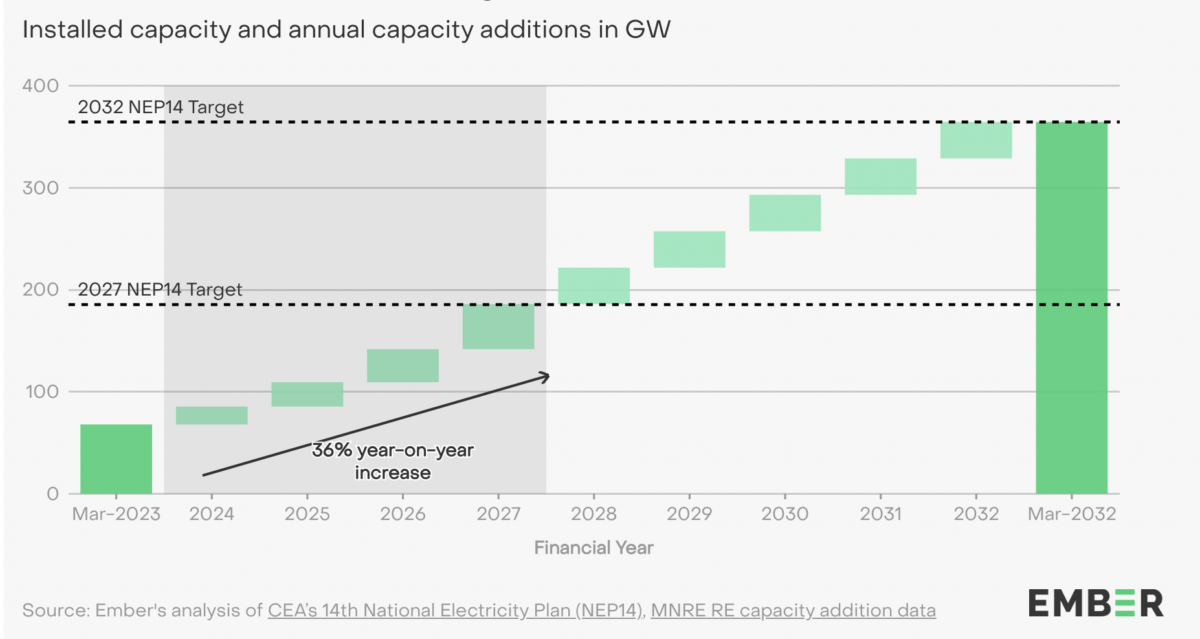India’s 14th National Electricity Plan (NEP14) sets out solar capacity targets of 185.6 GW by FY 2026-27, reaching 364.6 GW by FY 2031-32.
To achieve these targets, India needs to increase its current annual solar capacity addition by about 36% each year leading up to 2026-27, according to a recent report by Ember.
“The recent addition of 12.9 GW in FY 2023 [bringing the total national solar capacity to 66.7 GW] will be insufficient to reach the FY 2027 NEP solar capacity target of 185.6 GW. As the target year approaches, India would need to achieve a 36% year-on-year increase in solar capacity to remain on track for the 2027 goal. This means that India would need to commission a minimum of 17.5 GW in FY 2024, with a further ramp-up to 41 GW by FY 2027,” states the Ember report.
Ember adds that beyond FY 2027, even if India continues to sustain the annual build-rate of 41 GW/year, it will surpass its FY 2032 target capacity of 365 GW by a comfortable margin.
Solar and wind will fuel two thirds of India’s power generation growth in the 10-year period from FY 2022-32, should India meets its RE targets as outlined in NEP14.
NEP14, published by India’s Central Electricity Authority (CEA), estimates India’s total annual electricity generation to grow by 1,174 TWh in FY 2022-32 period, reaching a total of 2,666 TWh in FY 2032.
Solar generation is expected to rise from 73 TWh in FY 2022 to 666 TWh in FY 2032. Wind power will increase from 69 TWh to 258 TWh in the same time period.
“Annual solar and wind generation are expected to rise by 593 TWh and 189 TWh, respectively, which combined constitute 66% of India’s power generation growth in this 10-year period. This marks a significant transition from the preceding decade when coal power accounted for around 80% of generation growth,” states Ember.
If India achieves its solar targets set out in NEP14, solar’s share in the nation’s power mix is expected to increase five-fold from 5% in FY 2022 to 25% in FY 2032. This implies that the country’s power generation growth, predominantly driven by coal in the last decade, could enter a stage with most of its power expansion over the next ten years driven by solar and wind, provided India is on track to deliver its NEP14 targets.
Meanwhile, as India’s solar adoption widens, there is also a growing need for a much higher level of storage capacity to be able to manage peak demand in the evenings and early mornings, underscored by recent power shortages.
“India’s electricity supply landscape is projected to change quite significantly in the next decade or so, with solar and wind likely to drive the growth in generation,” says Neshwin Rodrigues, Ember’s India Electricity Policy Analyst. “Given their variable nature, a significant increase in storage capacity is crucial to balance generation and demand.”
This content is protected by copyright and may not be reused. If you want to cooperate with us and would like to reuse some of our content, please contact: editors@pv-magazine.com.









By submitting this form you agree to pv magazine using your data for the purposes of publishing your comment.
Your personal data will only be disclosed or otherwise transmitted to third parties for the purposes of spam filtering or if this is necessary for technical maintenance of the website. Any other transfer to third parties will not take place unless this is justified on the basis of applicable data protection regulations or if pv magazine is legally obliged to do so.
You may revoke this consent at any time with effect for the future, in which case your personal data will be deleted immediately. Otherwise, your data will be deleted if pv magazine has processed your request or the purpose of data storage is fulfilled.
Further information on data privacy can be found in our Data Protection Policy.